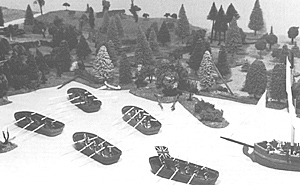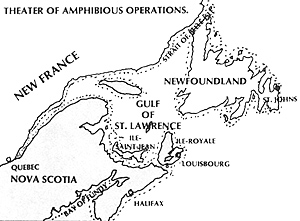 "AMPHIBIOUS ASSAULT". Rangers and grenadiers of the British Army lead line infantry into a secluded cove on a forested shoreline in North America during the French and Indian War. They are seconded by a small warship of the Royal Navy. Secluded French defenders have as yet withheld fire. The idea for the flat-bottomed boats and oars originally came from wargamer Dale Wood. The boats were once 7" long toy tugboats sold by the Toys R Us chain in the spring and summer last year. Removal of the superstructure converts them to great rowing watercraft. Oars we coffee stirrers from McDonald's restaurants. The ship is a 25mm Greenfield Hobbies warship. Miniatures are 25mm RSM British grenadiers and rangers with 30mm Sladden British line infantry and some Edward Suren (Willies) rangers. Sailors are 25mm Lamming and Miniature Figurines. The 25mm canoe is from RAFM, Inc. which sells two kinds plus paddlers. Photo by Bill Kojis.
"AMPHIBIOUS ASSAULT". Rangers and grenadiers of the British Army lead line infantry into a secluded cove on a forested shoreline in North America during the French and Indian War. They are seconded by a small warship of the Royal Navy. Secluded French defenders have as yet withheld fire. The idea for the flat-bottomed boats and oars originally came from wargamer Dale Wood. The boats were once 7" long toy tugboats sold by the Toys R Us chain in the spring and summer last year. Removal of the superstructure converts them to great rowing watercraft. Oars we coffee stirrers from McDonald's restaurants. The ship is a 25mm Greenfield Hobbies warship. Miniatures are 25mm RSM British grenadiers and rangers with 30mm Sladden British line infantry and some Edward Suren (Willies) rangers. Sailors are 25mm Lamming and Miniature Figurines. The 25mm canoe is from RAFM, Inc. which sells two kinds plus paddlers. Photo by Bill Kojis.
Thomas Moore Molyneux published "Conjunct Expeditions" in 1759. His purpose was to examine the nature of amphibious warfare. This was a very important subject to a naval power like Britain particularly in view of the war that was taking place at the time. Molyneux calculated that between 1603 and 1758, Britain had carried out 68 great and small amphibious operations. of the great, seven had succeeded and twenty-seven had failed. Of the small, twenty-three succeeded while eleven failed.
Had Molyneux written a few years later the success rate would have increased considerably. From 1758, the British Army and Navy conducted several large and small amphibious operations and practically all of them met with success. The only failure that I know of was the AngloPortuguese attack on the Spanish occupation of the Portuguese colony of Colonia on the River Plate in 1762. This was a disaster which is no doubt why it is virtually unknown! Apart from it, the record of success was unbroken with victories in West Africa, the West Indies, North America, the Far East and off of France; the latter with the capture of Belle Isle in 1762.
This article concentrates on seaborne operations in North America as part of the French and Indian War 1754-1763. I have selected three of these between 1758-1762: the assault landing at Louisbourg 8 June 1758, the amphibious operations that were part of the capture of Quebec in 1759 and the hastily mounted operation to recapture St. Johns, Newfoundland, from a French amphibious raiding force in September 1762. I have not described the course of these events but my intention is to draw out from the characteristic features of British amphibious warfare of the mid-Eighteenth Century so that anyone wishing to recreate such actions will have an idea of what the "Standard Operating Procedure" was.
 HISTORICAL BACKGROUND
HISTORICAL BACKGROUND
The war in North America was a colonial war fought over lands largely empty of people whether colonist or native. The main problems were largely logistic for both sides. in this, the British were immeasurably aided by the efficiency of the Royal Navy. it secured ascendancy over the French Navy which was vital, but it also contributed to the success of British arms in many other ways as well. For example, this produced expertise and skills plus greatenthusiasm and confidence. Any wargamer wishing to land successfully on an enemy shore should first ensure they have the Royal Navy on their side!
The North American theatre of war had other features that made operations easier. The armies were small by European standards. The British Army fielded 13,000 men at Louisbourg, 8,500 at Quebec and 1,559 at St. Johns. Above all, they had no cavalry. The transport and landing of horses was a very difficult task. Furthermore, the objectives were all close to the sea or to waterways so that heavy equipment such as siege artillery could be moved by boat and no lengthy approach marches were required.
British commanders in North America brought one valuable advantage with them. They were prepared to learn from experience. The lessons learnt from the operations that took place on the coast of France in 1757 were taken seriously. The landing at Louisbourg was one of the first to put into practice the newest techniques.
British Amphibious Operations in North America 1758-1762.
Back to Table of Contents -- Courier Vol. VIII No. 2
To Courier List of Issues
To MagWeb Master Magazine List
© Copyright 1988 by The Courier Publishing Company.
This article appears in MagWeb (Magazine Web) on the Internet World Wide Web.
Other military history articles and gaming articles are available at http://www.magweb.com